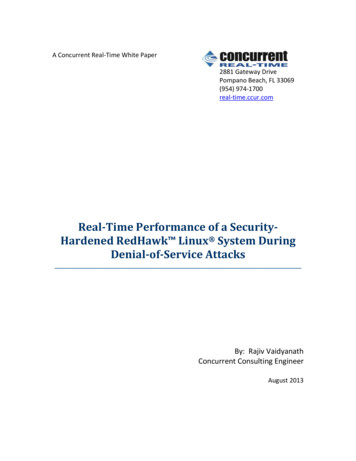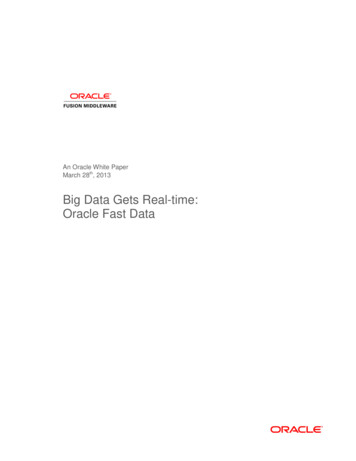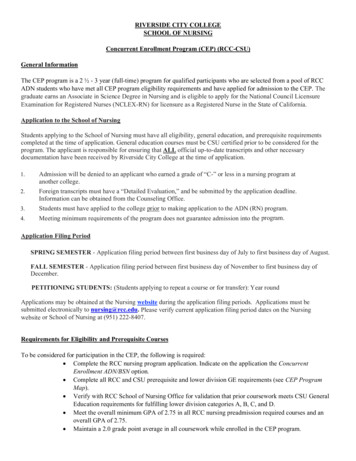
Transcription
A Concurrent Real‐Time White Paper2881 Gateway DrivePompano Beach, FL 33069(954) 974‐1700real‐time.ccur.comReal‐Time Performance of a Security‐Hardened RedHawk Linux System DuringDenial‐of‐Service AttacksBy: Rajiv VaidyanathConcurrent Consulting EngineerAugust 2013
AbstractThis paper is intended for those who wish to understand the real‐time performance of asecurity‐hardened RedHawk Linux system when it is under Denial‐of‐Service (DoS)attacks.NSA hardening guidelines and STIG rules are applied to harden the RedHawk Linuxsystem. Real‐Time performance of the RedHawk Linux system is measured while theattacks are in progress.A familiarity with RedHawk Linux system administration is assumed in this discussion.IntroductionA full installation of Kali Linux (http://kali.org) is deployed to launch DoS attacks on aRedHawk Linux system. Kali Linux is a Debian‐based Linux distribution that specializes inpenetration testing and vulnerability assessment. This distribution is supported andmaintained by Offensive Security (http://offensive‐security.com).The RedHawk Linux system is subjected to two types of DoS attacks. Apache Web Service denialDHCP StarvationWeb services are made unavailable by saturating the web server's tcp ports withconnection requests thereby denying legitimate requests for web pages. This type ofDoS attack can be mitigated by appropriate Netfilter/Iptables rules to drop traffic fromthe offending system.DHCP starvation denies clients of dhcp leases by overwhelming the dhcp server withbogus lease requests. Linux implements ISC DHCP which makes use of raw sockets.Packets from raw sockets are processed before they can be intercepted and filtered byNetfilter/Iptables rules. Mitigation for this attack has to be configured as a rate limitedoption in the network switch. We let the RedHawk Linux system endure this incursionfor the purpose of real‐time performance measurement.Real‐Time performance of a security‐hardened RedHawk Linux system duringDenial‐of‐Service attacksPage 2
Security‐Hardening of RedHawk LinuxProcedures stipulated by NSA's security‐hardening guidelines are followed to enhancethe security of the RedHawk Linux system, and it is configured as follows: SELinux is enabled and targeted policy is enforced.Netfilter/Iptables is enabled and configured only to allow necessary networkcommunication. Unwanted ports are closed and undesirable communication isset to be dropped.System services that are unnecessary are disabled.IPv6 is disabled.SUID/SGID bits for binaries are disabled.Auditing with STIG audit rules is enabled.SetupThe following RedHawk Linux system (hostname: ihawk) is selected for this benchmark:Hardware TYAN S2880 Motherboard Two CPU AMD Opteron 244 4G RAM (2G per NUMA node)Software RedHawk Linux 6.3.5 (64 bit) ccur‐rtbench package Apache Web Server package DHCP Server packageThe ccur‐rtbench package provides cyclictest to measure real‐time response time andstress to produce I/O, memory, CPU and disk loads. The system load is monitored via/proc/loadavg and stress is adjusted to provide a constant load of 50% of systemcapacity.Apache Web Server and DHCP Server are configured and started on ihawk.The attack host (hostname: kali) is a Dell Optiplex 790 running 64‐bit Kali Linux 1.0distribution. Two configurable applications ‐ slowHTTPTest and yersinia ‐ are launchedfrom kali targeting ihawk's Apache Web Server and DHCP Server.Real‐Time performance of a security‐hardened RedHawk Linux system duringDenial‐of‐Service attacksPage 3
Netfilter/Iptables rules are set on ihawk to drop packets originating from kali to its httpports 80 and 443.ihawk: # iptables ‐A INPUT ‐s 10.134.30.151/32 ‐p tcp ‐m tcp ‐‐dport 80 ‐j DROPihawk: # iptables ‐A INPUT ‐s 10.134.30.151/32 ‐p tcp ‐m tcp ‐‐dport 443 ‐j DROPAfter completing the previous step, a portscan of ihawk reveals that its Apache WebServer ports are being packet filtered.kali: # nmap ‐O ihawkStarting Nmap 6.25 ( http://nmap.org ) at 2013‐05‐01 16:31 EDTNmap scan report for ihawk (10.134.30.57)Host is up (0.00029s latency).PORT STATE SERVICE21/tcp closed ftp22/tcp open ssh23/tcp closed telnet25/tcp closed smtp80/tcp filtered http110/tcp closed pop3139/tcp closed netbios‐ssn443/tcp filtered https445/tcp closed microsoft‐ds3389/tcp closed ms‐wbt‐serverMAC Address: 00:E0:81:52:9D:37 (Tyan Computer)Device type: general purposeRunning: Linux 2.6.X 3.XOS CPE: cpe:/o:linux:linux kernel:2.6 cpe:/o:linux:linux kernel:3OS details: Linux 2.6.32 ‐ 3.6Network Distance: 1 hopOS detection performed. Please report any incorrect results at http://nmap.org/submit/Nmap done: 1 IP address (1 host up) scanned in 2.96 secondsA dhcping of ihawk from kali reveals that an active DHCP server is up and running onihawk.kali: # dhcping ‐s ihawkGot answer from: 10.134.30.57Real‐Time performance of a security‐hardened RedHawk Linux system duringDenial‐of‐Service attacksPage 4
Enabling DoS AttacksThe application layer DoS tool slowhttptest is invoked from kali targeting ihawk'sApache Web Server.kali: # slowhttptest ‐c 1000 ‐H ‐g ‐o stat ‐i 10 ‐r 200 ‐t GET ‐u http://ihawk.ccur.com ‐x 24 ‐p 3 ‐l 86400Wed May 1 16:43:36 2013:Using:test type:SLOW HEADERSnumber of connections: ngth header value:4096follow up data max size:52interval between follow up data: 10 secondsconnections per seconds:200probe connection timeout:3 secondstest duration:86400 secondsusing proxy:no proxyWed May 1 16:43:36 2013:slow HTTP test status on 0th osed:0service available: YESWed May 1 16:43:41 2013:slow HTTP test status on 5th closed:0service available: NO.Note that since packet filtering is active on ihawk all packets from kali to ihawk's httpport are dropped. At this point http://ihawk.ccur.com will still be accessible from anysystem other than kali within the same network.Real‐Time performance of a security‐hardened RedHawk Linux system duringDenial‐of‐Service attacksPage 5
Next, the layer 2 DoS tool yersinia is invoked from kali targeting ihawk's DHCP Server.kali: # yersinia dhcp ‐attack 1 ‐dest 00:E0:81:52:9D:37 * Starting DOS attack sending DISCOVER packet. * Press any key to stop the attack * Within a few seconds of invoking yersinia on kali, the DHCP Server on ihawk is saturatedwith bogus lease requests and the following syslog messages appear:May 1 16:46:03 ihawk dhcpd: DHCPDISCOVER from 52:4b:b3:39:4d:10 via eth1: network 10.134.30.0/24: no free leasesMay 1 16:4603 ihawk dhcpd: DHCPDISCOVER from 82:03:75:19:f6:20 via eth1: network 10.134.30.0/24: no free leasesMay 1 16:46:03 ihawk dhcpd: DHCPDISCOVER from 54:e8:92:0d:d6:fb via eth1: network 10.134.30.0/24: no free leasesMay 1 16:46:03 ihawk dhcpd: DHCPDISCOVER from 52:f7:04:25:ba:48 via eth1: network 10.134.30.0/24: no free leasesMay 1 16:46:03 ihawk dhcpd: DHCPDISCOVER from d6:49:38:07:bf:cf via eth1: network 10.134.30.0/24: no free leasesMay 1 16:46:03 ihawk dhcpd: DHCPDISCOVER from d4:ef:8c:08:a0:67 via eth1: network 10.134.30.0/24: no free leasesMay 1 16:46:03 ihawk dhcpd: DHCPDISCOVER from 06:d7:11:06:c4:38 via eth1: network 10.134.30.0/24: no free leasesMay 1 16:46:03 ihawk dhcpd: DHCPDISCOVER from d2:ca:1b:42:d4:82 via eth1: network 10.134.30.0/24: no free leasesReal‐Time Performance MeasurementOn ihawk, a NUMA node is shielded for interrupts, processes, local timer interrupts andcross node memory activities and cyclictest is started.ihawk: # shield ‐a n1 ‐m1ihawk: # cyclictest ‐a 1 ‐m ‐p 95System load generator stress is started from a different xterm window.ihawk: # stress ‐‐cpu 20 ‐‐io 10 ‐‐vm 10After 24 hours, cyclictest measures a worst‐case response time of 16 microseconds.ConclusionsSecurity‐hardening of RedHawk Linux diminishes the attack surface and restricts asystem from vulnerabilities and exploits. As evidenced by this benchmark, imposingstrict security policies on a RedHawk Linux system does not affect its real‐timeperformance.Real‐Time performance of a security‐hardened RedHawk Linux system duringDenial‐of‐Service attacksPage 6
About Concurrent Real‐TimeConcurrent Real‐Time is a global leader in innovative solutions serving the aerospaceand defense, automotive, and financial industries. As the industries’ foremost providerof high‐performance real‐time computer systems, solutions, and software forcommercial and government markets, Concurrent Real‐Time focuses on hardware‐in‐the‐loop and man‐in‐the‐loop simulation, data acquisition, and industrial systems.Concurrent’s Real‐Time product group is located in Pompano Beach, Florida withadditional offices in North America, Europe, Asia and Australia. For more information,please visit Concurrent Real‐Time at www.real‐time.ccur.com. 2013 Concurrent Computer Corporation. Concurrent Computer Corporation and its logo areregistered trademarks of Concurrent. All other Concurrent product names are trademarks ofConcurrent, while all other product names are trademarks or registered trademarks of theirrespective owners. Linux is used pursuant to a sublicense from the Linux Mark Institute.Real‐Time performance of a security‐hardened RedHawk Linux system duringDenial‐of‐Service attacksPage 7
Procedures stipulated by NSA's security‐hardening guidelines are followed to enhance the security of the RedHawk Linux system, and it is configured as follows: SELinux is enabled and targeted policy is enforced. Netfilter/Iptables is enabled and co










